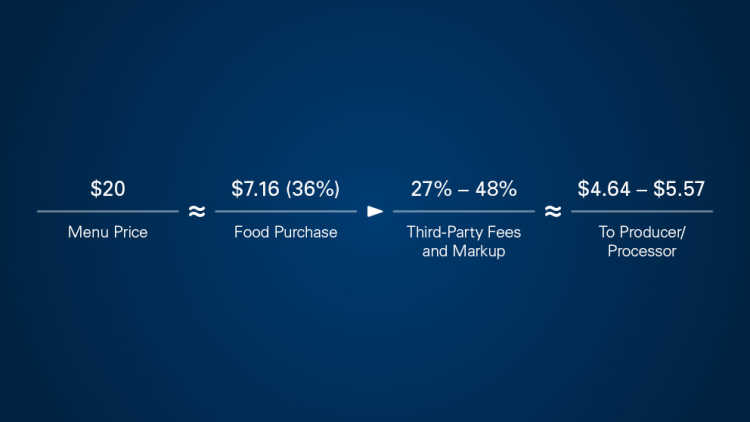Order up: Selling to Canada’s food service industry

With an estimated $34 billion in annual food purchases, Canada’s foodservice industry is a sizable market for food producers and processors.
How is this opportunity accessed?
Foodservice is multifaceted, ranging from commercial restaurants (businesses whose sole purpose is to serve food) to non-commercial institutions such as healthcare and universities (operations that must serve food but whose primary purpose is something else).
Several operating models exist. Commercial foodservice may be an independent concept or a chain operated by one company or franchisees. Non-commercial foodservice may be self-operated (run by the institution) or contracted to a caterer.
Producers and processors typically sell to operators through third-party distribution channels, each with unique needs and shared challenges.
Know who to sell to
Sell to the person who makes purchasing or menu development decisions.
The contact at an independent restaurant might be the owner or chef. At a chain restaurant, the right contact is usually a corporate/executive chef, purchaser or in the marketing department at the head office. Franchisees and unit-level management rarely contribute to chain menu development.
In non-commercial foodservice, a purchaser, executive chef, director of food services, corporate services or ancillary services may make purchase decisions.
Contract caterers may make menu decisions at the individual location or a regional office. Asking for the executive chef or director of food services at the location is a good place to start.
The exact title may vary by operation but seeking these roles first will direct you to the correct contact.
Know who to sell through
Food service operators purchase through third-party channels, rarely direct from producers/processors.
The most common distribution channel is broadline distributors, but some products may be sourced through alternate channels such as cash-and-carry, specialty suppliers, group purchasing organizations or brokers.
Operators prefer to purchase through their current suppliers. Often, this is a requirement if the operator has an exclusive contract with a distributor, which is common in institutions or chain restaurants.
Broadline distributors purchase, sell and deliver products to the operator and typically mark up the price by 20% to 30%. Producers and processors should not expect the distributor to promote their products for them.
Broadline distributors have mandatory requirements such as minimum sales volumes, HACCP plans and traceability, liability waivers, nutrition data, specific labelling formats and proof of market demand for the product, among other needs.
Operators may also purchase through a group purchasing organization. GPOs leverage purchasing power by combining the purchase volumes of their membership. GPOs negotiate manufacturer rebates for their memberships, often in the range of 4% to 8%.
Brokers help producers and processors navigate the distribution chain and market the product to the industry. Brokers have industry experience, connections and data that benefit their clients. Brokers often work on a commission that varies with the level of service required. Commissions may range from 3% to 10% of sales.
The economics of a menu
Commercial foodservice operators are subject to competitive pricing, and non-commercial operators have strict budgets. Understanding menu economics helps producers and processors develop successful pricing strategies.
Understanding menu economics helps producers and processors develop successful pricing strategies.
On average, ingredient costs represent 36% of foodservice revenue, referred to as food cost or the cost of goods sold, or COGS, ratio. The COGS ratio will vary by operation and menu item, but knowing the average is helpful for illustrative purposes.
When developing a pricing strategy, remember the distribution, marketing services and rebates between the operator and the producer/processor. These figures help determine a realistic portion cost, working back from a known menu price, like in the following example.

Here, a $20 menu item might represent an opportunity of $4.64 to $5.57. Products are usually one part of a recipe. Core items, like centre-of-plate proteins, will demand most of the ingredient cost. Products like packaging, side dishes, sauces or garnishes will have significantly smaller shares of this opportunity.
COGS are the greatest expense for foodservice operators, but labour is a close second, representing 31% of revenue.
Successful restaurants attempt to keep combined COGS and labour below 60% to achieve net profits of 15% to 17%; however, most operators find this challenging. The industry average net profit (pre-pandemic) was only 3.8%, illustrating margin sensitivity.
Be the hero
Having a delicious product is a qualifier, not a differentiator. Successful products solve a challenge for the operator.
Labour is a significant challenge for operators, not only rising costs but the availability of workers. In 2022, accommodation and foodservice had the greatest job vacancy rate (11.9%) of any Canadian industry.
Operators look to suppliers for menu innovation and ways to differentiate from competitors.
Innovation can be as simple as having the correct case format or portion size but may also align menus with underlying trends.
Current trends include, but are not limited to:
Local food
Clean ingredient lists
Portability (more products are consumed off-site now than pre-pandemic)
Labour-saving products
Flexibility
Be prepared
Understand that your sales contact is busy and is approached regularly with new products. Have a sell sheet highlighting the product’s benefits, case formats and specifications. Bring samples. Be prepared to discuss pricing and production capacity and to show precedence for your product (letters from interested buyers, success in other markets like retail sales, etc.).
Show that you understand their needs, offer a solution and make it easy for them to say “yes.”
Article by: Andrew Waddington, Principal, fsSTRATEGY Inc.

Applying these strategies can help ride the wave of higher debt and costs and sliding consumer demand.

